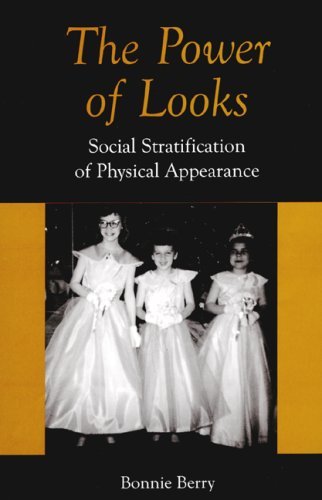The Power of Looks: Social Stratification of Physical Appearance
Berry, Bonnie
Ashgate, Aldershot
2008
9780754647584 (hb)
 Bonnie Berry's growing body of academic work covers the complex human territory where emotional life and corporeal being impact upon and are impacted by social forces, institutions and processes. Berry's Social Rage: Emotion and Cultural Conflict (1999) followed in 2007 by Beauty Bias: Discrimination and Social Power provide good foundations for the present book under review, The Power of Looks: Social Stratification of Physical Appearance. The overall frame of reference of this oeuvre is social aesthetics, a sphere of intellectual operations where 'appearance traits' (Preface viii) rub up against cultural norms, spiritual values and visceral reactions in ways both subtle and gross. Lacuna in Berry's previous publications in this sensitive subject sphere – theory, method, international and cross-cultural aspects – are here made good, at least to a degree.
Bonnie Berry's growing body of academic work covers the complex human territory where emotional life and corporeal being impact upon and are impacted by social forces, institutions and processes. Berry's Social Rage: Emotion and Cultural Conflict (1999) followed in 2007 by Beauty Bias: Discrimination and Social Power provide good foundations for the present book under review, The Power of Looks: Social Stratification of Physical Appearance. The overall frame of reference of this oeuvre is social aesthetics, a sphere of intellectual operations where 'appearance traits' (Preface viii) rub up against cultural norms, spiritual values and visceral reactions in ways both subtle and gross. Lacuna in Berry's previous publications in this sensitive subject sphere – theory, method, international and cross-cultural aspects – are here made good, at least to a degree.
Berry's focus is on the diverse, deep-rooted and deep-wounding social inequalities associated with physical appearance. The normative order of beauty and ugliness is socially constructed, reinforced, sometimes challenged and, occasionally, changed. Positive and negative social reactions to 'looks', Berry tells us, come in many forms and are 'stratified' in multiple ways. Looks, especially 'good looks' that appeal to the public eye, are 'power', power to persuade, seduce, attract wealth and status associations, command recognition, and 'earn' vicarious 'rewards' from sexual to career to political favours. By contrast, 'uglies', the 'Others' incarnate, get a raw deal. The 'also rans', in the cruel, cold, cosmetisized game of beautification, attract stigma and discrimination, society's revenge on Nature's 'aesthetically challenged'. What might be called a global 'beauty caste' system is in the making as the internationalization of the 'appearances are everything' industry with its glamour and style stereotypes invades and pervades cyberspace, roadside hoardings, 'looks product' commerce, and the 'world system' of 'human and non-human constructed beauty' (p. 103). Berry's insights on 'the practice of humans associating themselves with non-human animals on the basis of the latter's appearance' (Ch. 9, p. 99) draw the reader into the fascinating world of the use and abuse of animals in symbolic interaction.
The Power of Looks: Social Stratification of Physical Appearance brings the hierarchical power of beauty and appearance into the ever-expanding, increasingly differentiated multiple pyramids of stratifications based on social class, race, gender, sexual orientation, age, ableness and so on. Make-up and 'cosmeceuticals' (p. 52), the photographic arts, diets hormones and steroids, prosthetics and the surgeon's knife, all serve to generate within an 'obesogenic environment' (p. 44) the preconditions for what Berry call 'ugly laws' (pp. 34; 46-7), those ordinances, sometimes formalised in official statutes, that restrict the social space and movement of the new class of 'unsightly beggars'. Whatever the dreams of 'fat pride' and 'thin pride' and the evidence of the long march of the uglies, the truly hidden from history, the 'new meritocracy' (p. 27) of the 'attractive' claim the spoils of victory in the marketplace. The notion of 'an equalization, a democratization, of beauty' (p. 57) seems somewhat stretched against the backdrop of expensive health farms, personal trainers, reconstructive rhinoplasties, select 'Russian thread lifts' (p. 55) and other such 'solutions' to the 'ugly problem' costing an arm and a leg.
Berry's methodological observations (Ch. 7) on interviews, participant observation, surveys, anecdotes, diaries, ethnographies, autobiographies content analysis, archival data, and visual sociology are rather succinct. But they show how 'social aesthetics' can be given empirical embodiment. 'Looksism' (p. 125) provides a limitless research world for those who wish to connect somatic sociology and the more traditional sociological agendas of economy, power politics and ideology.
Berry's book demonstrates how life chances and physical appearance are intimately interconnected, a social bond that brings much power, pleasure and pain in its wake. Maybe we were spared any visual supports in this volume for good reason. But in a book on 'looks' it does seem an oversight.
References
Berry, Bonnie (1999) Social Rage: Emotion and Cultural Conflict, New York, NY: Garland/Taylor and Francis.Berry, Bonnie (2007) Beauty Bias: Discrimination and Social Power, Westport, CT: Praeger/Greenwood.
William Keenan
Nottingham Trent University

